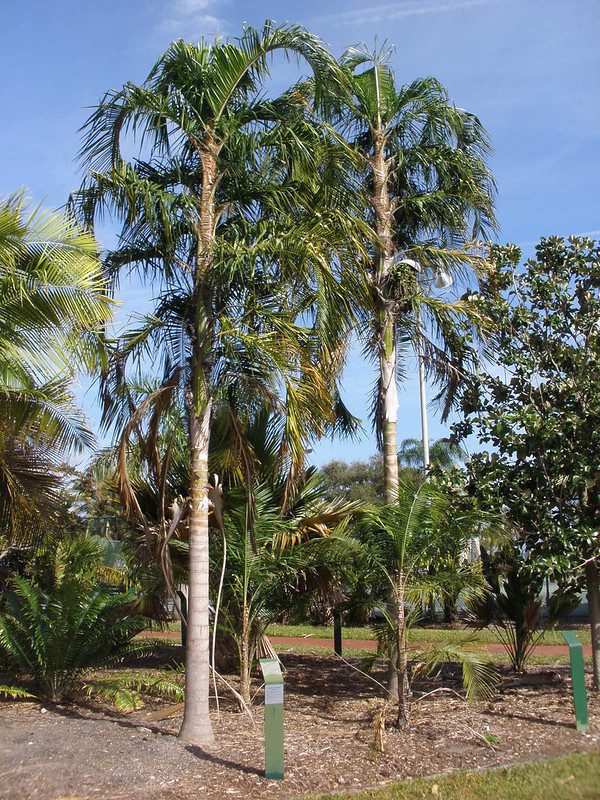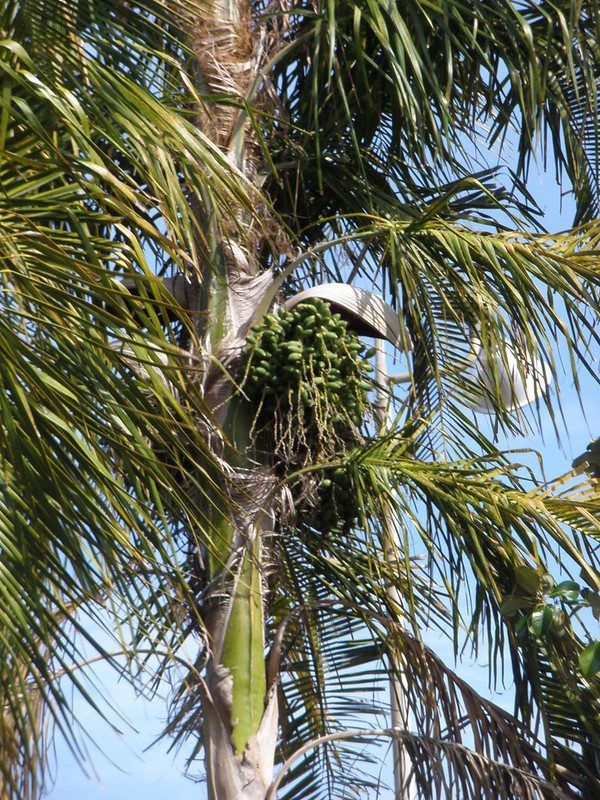The Pati Queen Palm is an ornamental palm tree that stands out for its layered crown with a vertical appearance. It is native to Brazil, specifically the Atlantic Forest, occurring in the states of Espírito Santo, Minas Gerais, Bahia, and Sergipe. It is listed as an endangered species due to the significant deforestation of the Atlantic Forest. Despite still being rare in cultivation, its demand in landscaping is growing, which can be highly valuable for preserving the species.
It features a solitary, columnar stem called a stipe, which is slender and light gray in color, with a diameter of up to 25 cm (10 inches) and reaching a height of 18 meters (60 feet). The stem may be partially covered by remaining leaf sheaths, giving it a fibrous appearance. Its dark green, pinate leaves are curved and rigid, spirally arranged along the stem, creating the impression of leaf layers. Each leaf has 100 to 180 linear leaflets arranged in the same plane. It differs from the Queen Palm (Syagrus romanzoffiana), which has feather-like leaves arranged radially in a crown. Its inflorescences are panicles, hanging between the leaves, bearing numerous cream-colored flowers. It abundantly bears small ellipsoidal fruits with fibrous, orange-colored drupe-like exteriors and a sweet taste with a tough endocarp.

It’s no wonder that American palm expert Paul Craft classified the Pati Queen Palm as one of the most beautiful palms in the world in the book “Encyclopedia of Cultivated Palms,” of which he is a co-author. With its unique beauty, this species can be planted individually, in rows, or even in groups, preferably with specimens of varying heights against the backdrop of the open sky to enhance its vertical crown. Therefore, the Pati Queen Palm is perfect for landscaping around pools, parks, estates, farms, along pathways, or near multi-story residences, allowing its scale to complement the architecture.
Moreover, young plants can be grown in pots to adorn indoor spaces and later transplanted into the garden. Compared to other palms, the Pati Queen Palm is known for its rapid growth, easy transplantation, and low maintenance. Some even suggest avoiding excessive fertilization to prevent disproportionate growth in relation to the plant’s support.
Beyond its landscaping utility, the Pati Queen Palm produces tasty fruits and almonds that can be enjoyed fresh or used in liqueurs. Valuable fine oil can also be extracted from them. The stem finds use in rural constructions, while the leaves are ingeniously used by indigenous people as excellent wrappers for baking fish.

Imitating the natural protection of the forest, initial cultivation should be done in partial shade or filtered light to safeguard the early development of seedlings. As they grow, they can gradually be exposed to full sunlight. The Pati Queen Palm thrives in well-draining soil enriched with organic matter. When potted, regular watering is needed to prevent the substrate from completely drying between waterings.
In the garden, it’s advisable to irrigate during dry periods since its roots are not deeply embedded, unlike the majority of palm trees. It moderately tolerates the salinity of coastal regions. It’s sensitive to intense cold and heavy frosts but can withstand milder subtropical cold. Strong winds and storms can lead to its downfall, so it’s not recommended for excessively exposed areas that could pose risks to people or structures.
Fertilize during spring and summer using palm-specific fertilizers, following the manufacturer’s recommendations. Ensure the soil is well-watered before applying fertilizer to facilitate nutrient absorption and prevent root burn. Propagation is achieved through seed planting, with germination occurring between 3 to 5 months. Mechanical scarification can accelerate and standardize germination. Fresh seeds harvested from ripe and depulped fruits are ideal for this purpose.


